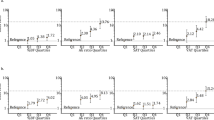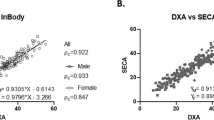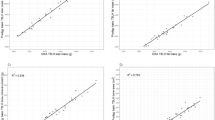Abstract
Objective: To determine whether dual-energy X-ray absorptiometry (DXA) is a valid method for body composition assessment of obese and non-obese subjects.
Design: Cross-sectional study.
Subjects: Chinese women living in Hong Kong; 66 of 91 subjects had body mass index (BMI) of >25 kg/m2.
Measurements: Anthropometrics, including body weight, body height, waist and hip girth. Percentage body fat (%BF) and fat-free mass (FFM) from DXA (Hologic 2000 plus, Enhanced Array Whole Body Version 5.63) were compared with that based on a tracer dose of deuterium oxide for the determination of total body water (TBW).
Results: In both obese and non-obese subjects, FFMDXA was similar to FFMTBW. The Bland and Altman-type analysis indicated that comparable between-methods differences (mean bias) and limits of agreement were obtained in obese and non-obese subjects for FFM (0.4, between −4.4 and 5.2 kg vs 0.5, between −3.1 and 4.1 kg) and %BF (−0.6, between −7.6 and 6.4% vs −1.2, between −8.6 and 6.2%). The %BF bias was independent of age, BMI, hip circumference, and waist-to-hip ratio, but correlated with waist girth (r=0.24, P=0.021).
Conclusion: The sources of bias are methodological and anthropometric in nature. The between-methods differences, however, are small and clinically insignificant. DXA is a valid method for assessing the body composition of obese patients.
Sponsorship: This study was supported by a HKU-CRCG grant.
This is a preview of subscription content, access via your institution
Access options
Subscribe to this journal
Receive 12 print issues and online access
$259.00 per year
only $21.58 per issue
Buy this article
- Purchase on Springer Link
- Instant access to full article PDF
Prices may be subject to local taxes which are calculated during checkout
Similar content being viewed by others
Author information
Authors and Affiliations
Contributions
Guarantor: ETS Li.
Contributors: MH was responsible for executing the study, which included subject recruitment, operating the DXA and measuring total body water. She also analyzed the data and drafted the manuscript. AK was responsible for referral of obese subjects and their medical examinations, and assisted in study design and drafting the manuscript. EL was responsible for study design, statistical analysis and revisions of the draft manuscript.
Corresponding author
Rights and permissions
About this article
Cite this article
He, M., Li, E. & Kung, A. Dual-energy X-ray absorptiometry for body composition estimation in Chinese women. Eur J Clin Nutr 53, 933–937 (1999). https://doi.org/10.1038/sj.ejcn.1600875
Received:
Revised:
Accepted:
Published:
Issue Date:
DOI: https://doi.org/10.1038/sj.ejcn.1600875
Keywords
This article is cited by
-
Effects of a programme for years enderers physical force on the muscle and body composition of adults
Sport Sciences for Health (2008)
-
Bone status of Indian women from a low-income group and its relationship to the nutritional status
Osteoporosis International (2005)
-
Low body mass index but high percent body fat in Taiwanese subjects: implications of obesity cutoffs
International Journal of Obesity (2003)
-
Prediction of Body Fat by Anthropometry in Older Chinese People
Obesity Research (2001)
-
Body fat determination by dual energy X-ray absorptiometry and its relation to body mass index and waist circumference in Hong Kong Chinese
International Journal of Obesity (2001)



